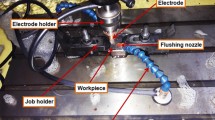Abstract
The objective of this study was to investigate the effects of the micro-electro-discharge machining (micro-EDM) process parameters on the machining performance parameters, in order to understand the behavior of each process parameter as well as to find out their optimal values. This research was conducted through a series of experiments using full factorial design. Analysis of variance (ANOVA) and multivariate analysis of variance (MANOVA) were employed to analyze the findings and to determine the significance of each process parameters on the response variables. The process parameters included in this study were voltage, capacitance, electrode rotational speed, and the electrode coating. Voltage and capacitance were studied separately as well as in combination in terms of the discharge energy. The response variables were consisted of machining time, tool wear, crater size, and surface micro-hardness. The findings indicated that the increase in voltage had a decreasing effect on the machining time, while it increased the crater size. The increase in capacitance resulted in decreased machining time and the tool wear, while it had an increasing effect on the surface micro-hardness. It was found that the effects of titanium nitride (TN) coating and the electrode rotational speed were not statistically significant. There was slight improvement of machining time and accuracy for increasing electrode rotational speed due to improved flushing condition, but very high electrode rotational speed was found to be unsuitable for machining accuracy. The overcut of the micro-holes was found to increase gradually with the increase of voltage and capacitance due to increase in spark gap and discharge duration, respectively. The voltage and the capacitance were found to be the two major parameters influencing the micro-EDM performance. Assuming that the importance and the weight of all response variables had been identical, the optimal process parameters for improved micro-EDM of Ti-6Al-4V were found to be TN-coated electrode, 60 V, 4700 pF, and 3000 rpm.
Similar content being viewed by others
References
Kalpakjian S, Schmid SR (2006) Manufacturing engineering and technology. Pearson Education, Inc., Upper Saddle River
Moses MD, Jahan MP (2015) Micro-EDM machinability of difficult-to-cut Ti-6Al-4V against soft brass. Int J Adv Manuf Technol 81(5):1345–1361
Jameson EC (2001) Electrical discharge machining. Society of Manufacturing Engineers, Dearborn, Michigan
Jahan MP, Rahman M, Wong Y (2011) A review on the conventional and micro-electrodischarge machining of tungsten carbide. Int J Mach Tools Manuf 51(12):837–858
Fonda P, Wang Z, Yamazaki K, Akutsu Y (2007) A fundamental study on Ti-6Al-4V’s thermal and electrical properties and their relation to EDM productivity. J Mater Process Technol 202(1–3):583–589
Kao JY, Tsao CC, Wang SS, Hsu CY (2010) Optimization of the EDM parameters on machining Ti–6Al–4V with multiple quality characteristics. Int J Adv Manuf Technol 47(1–4):395–402
HascAlik A, Caydas H (2007) A comparative study of surface integrity of Ti-6Al-4V alloy machined by EDM and AECG. J Mater Process Technol 190:173–180
Nourbakhsh F, Rajurkar KP, Malshe AP, Cao J (2013) Wire electro-discharge machining of titanium alloy. Procedia CIRP 5:13–18
Ndaliman MB, Khan AA, Ali MY (2013) Influence of electrical discharge machining process parameters on surface micro-hardness of titanium alloy. J Eng Manuf 227:460–464
Thesiya D, Rajurkar A, Patel S (2014) Heat affected zone and recast layer of Ti-6Al-4V alloy in the EDM process through scanning electron microscopy (SEM). J Manuf Technol Res 6(1):41–47
Kuriakose S, Shunmugam MS (2004) Characteristics of wire-electro discharge machined Ti-6Al-4V surface. Mater Lett 58:2231–2237
Alias A, Abdullah B, Abbas MN (2012) Influence of machine feed rate in WEDM of titanium Ti-6Al-4V with constant current (6A) using brass wire. Procedia Eng 41:1806–1811
Aspinwall DK, Soo SL, Berrisford AE, Walder G (2008) Workpiece surface roughness and integrity after WEDM of Ti–6Al–4V and Inconel 718 using minimum damage generator technology. CIRP Ann Manuf Technol 57:187–190
Meena VK, Azad MS (2002) Grey relational analysis of microEDM machining of Ti6Al4V alloy. Mater Manuf Process 27(9):973–977
Phipon R, Pradhan BB (2012) Process parameters optimization of micro electric discharge machining process using genetic algorithm. Int J Eng Res App 2(5):1986–1993
Kuriachen B, Mathew J (2014) Modeling of material removal mechanism in micro electric discharge milling of Ti-6Al-4V. Appl Mech Mater 592-594:516–520
Sivaprakasam P, Hariharan P, Gowri S (2014) Modeling and analysis of micro-WEDM process of titanium alloy (Ti-6Al-4V) using response surface approach. Eng Science Technol Int J 17:227–235
Kibria G, Sarkar BR, Pradhan BB, Bhattacharyya B (2010) Comparative study of different dielectrics for micro-EDM performance during micro-hole machining of Ti-6Al-4V alloy. Int J Adv Manuf Technol 48:557–570
Ali MY, Rahman NABA, Aris EBM (2011) Powder mixed micro electro discharge milling of titanium alloy: investigation of material removal rate. Adv Mater Res 383-390:1759–1763
Kuriachen B, Mathew J (2016) Effect of powder mixed dielectric on material removal and surface modification in micro electric discharge machining of Ti6Al4V. Mater Manuf Process 31(4):439–446
Jahan MP, Wong YS, Rahman M (2010) A comparative experimental investigation of deep-hole micro-EDM drilling capability for cemented carbide (WC-Co) against austenitic stainless steel (SUS 304). Int J Adv Manuf Technol 46:1145–1160
Jahan MP, Wong YS, Rahman M (2009) A study on the fine-finish die-sinking micro-EDM of tungsten carbide using different electrode materials. J Mater Process Technol 209(8):3956–3967
Author information
Authors and Affiliations
Corresponding author
Rights and permissions
About this article
Cite this article
Alavi, F., Jahan, M.P. Optimization of process parameters in micro-EDM of Ti-6Al-4V based on full factorial design. Int J Adv Manuf Technol 92, 167–187 (2017). https://doi.org/10.1007/s00170-017-0103-x
Received:
Accepted:
Published:
Issue Date:
DOI: https://doi.org/10.1007/s00170-017-0103-x




